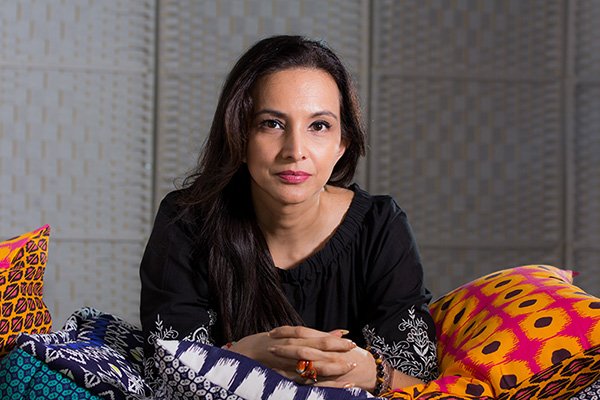
Kamini Ramachandran: Telling the Story of a Storyteller
Project Gallery
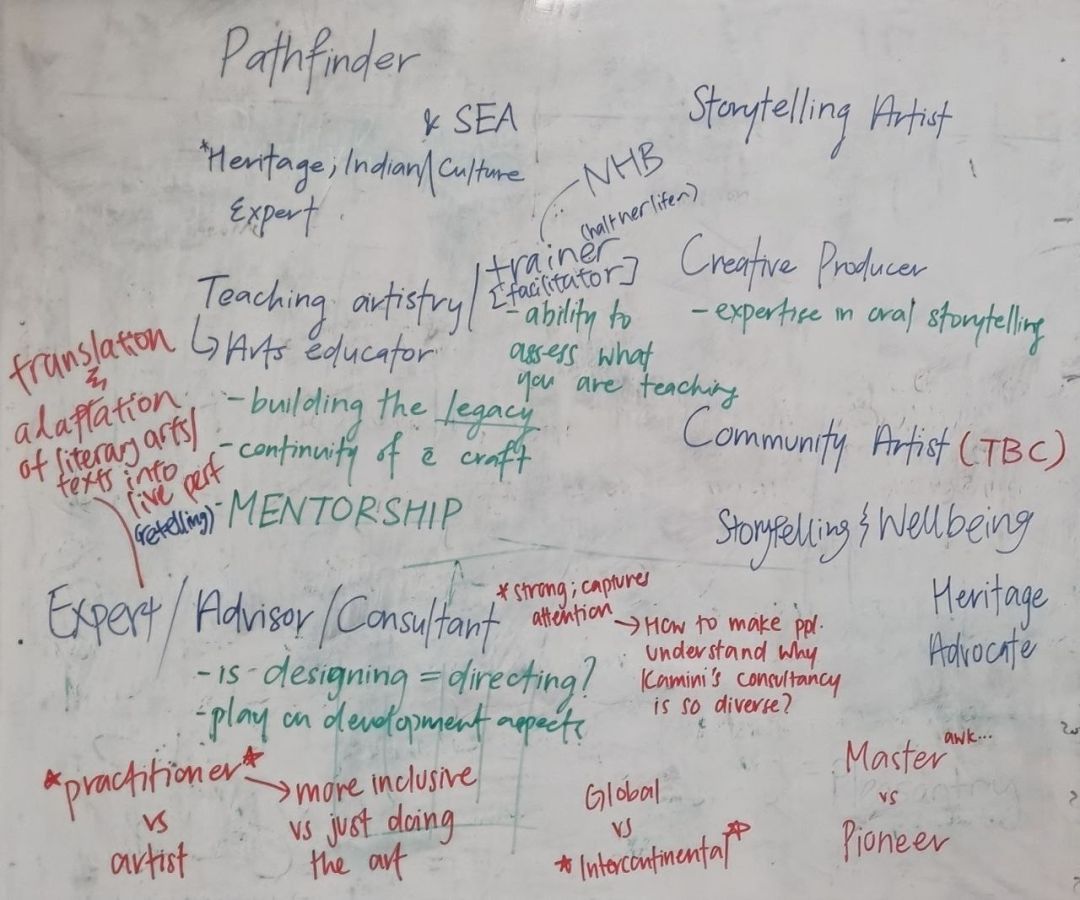
Brainstorming for LinkedIn
A visual representation of the brainstorming process with Kamini when coming up with the different skill categories for her LinkedIn page.

Visiting Kamini at her residency at Goethe Lab
In order to better understand who Kamini is as an artist, we paid a visit to her during her residency at Goethe Labs. We took part in her installation 'Tell It To The Walls'.
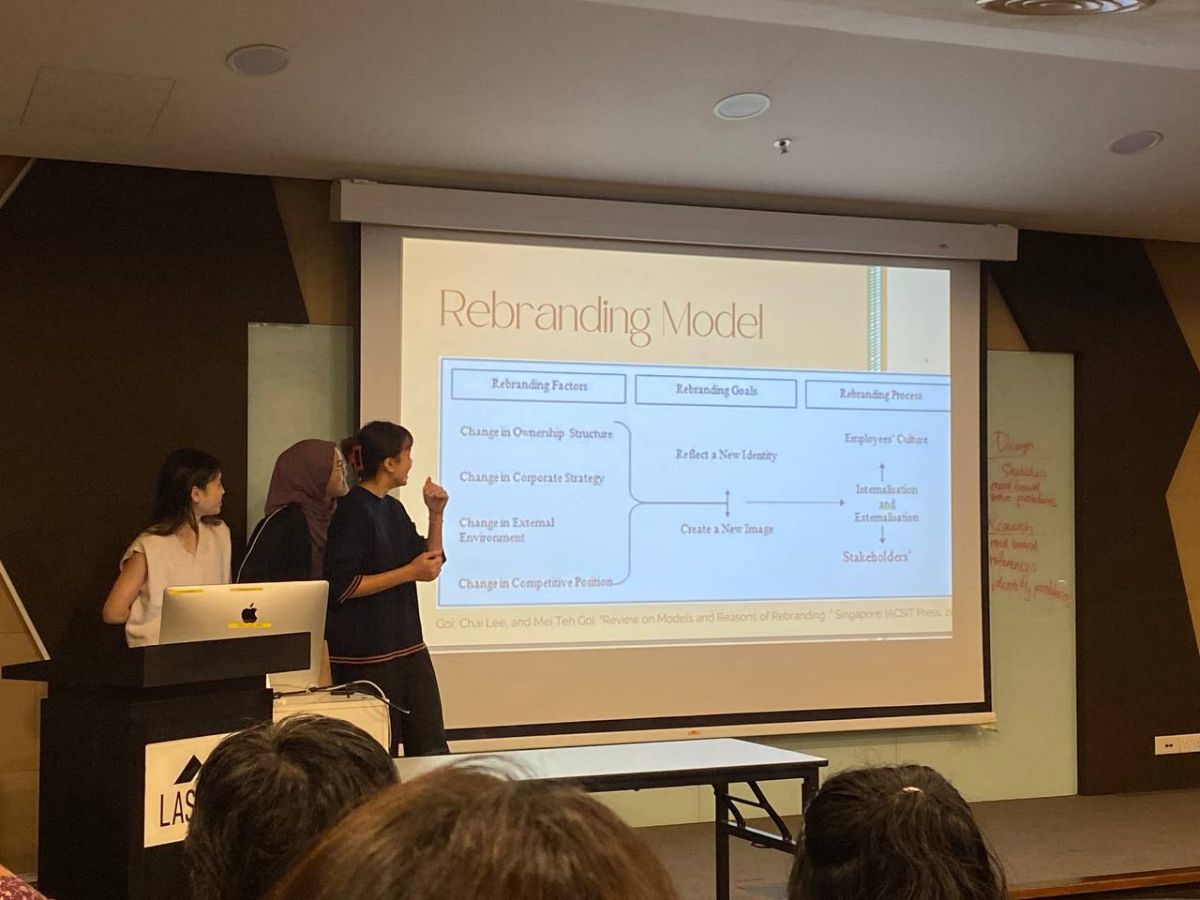
The team's first pitch
Our first pitch was about consolidating feedback about our ideas and hearing what other industry partners and supervisors had to say about our progress. During this session, we got to justify our ideas and found loopholes to address.
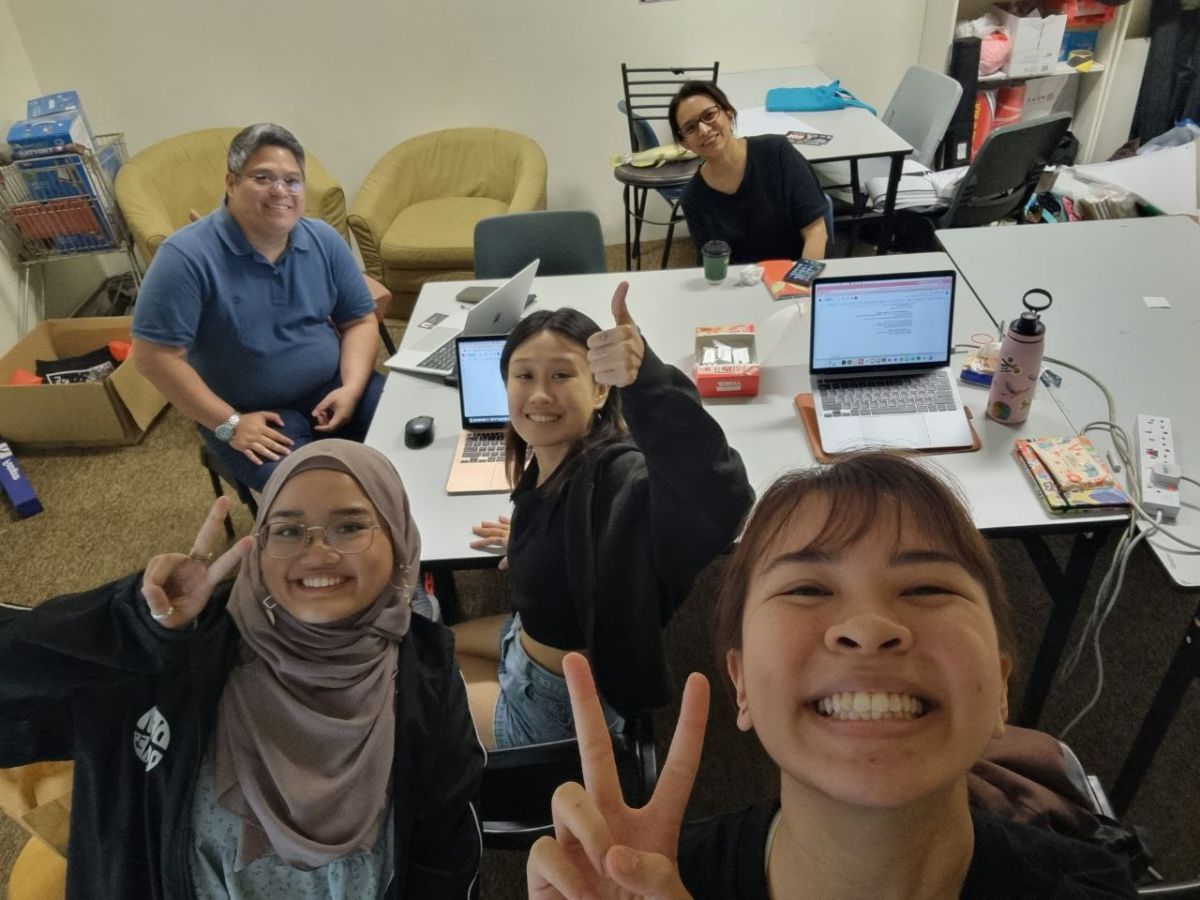
Last meeting with Jason and Kamini: gearing up for presentation day!
This was our last meeting with Jason and Kamini before presentation day. This meeting was loaded with feedback and comments on our progress thus far from both Jason and Kamini. We also got to work on the LinkedIn information bank with Kamini extensively on this day.
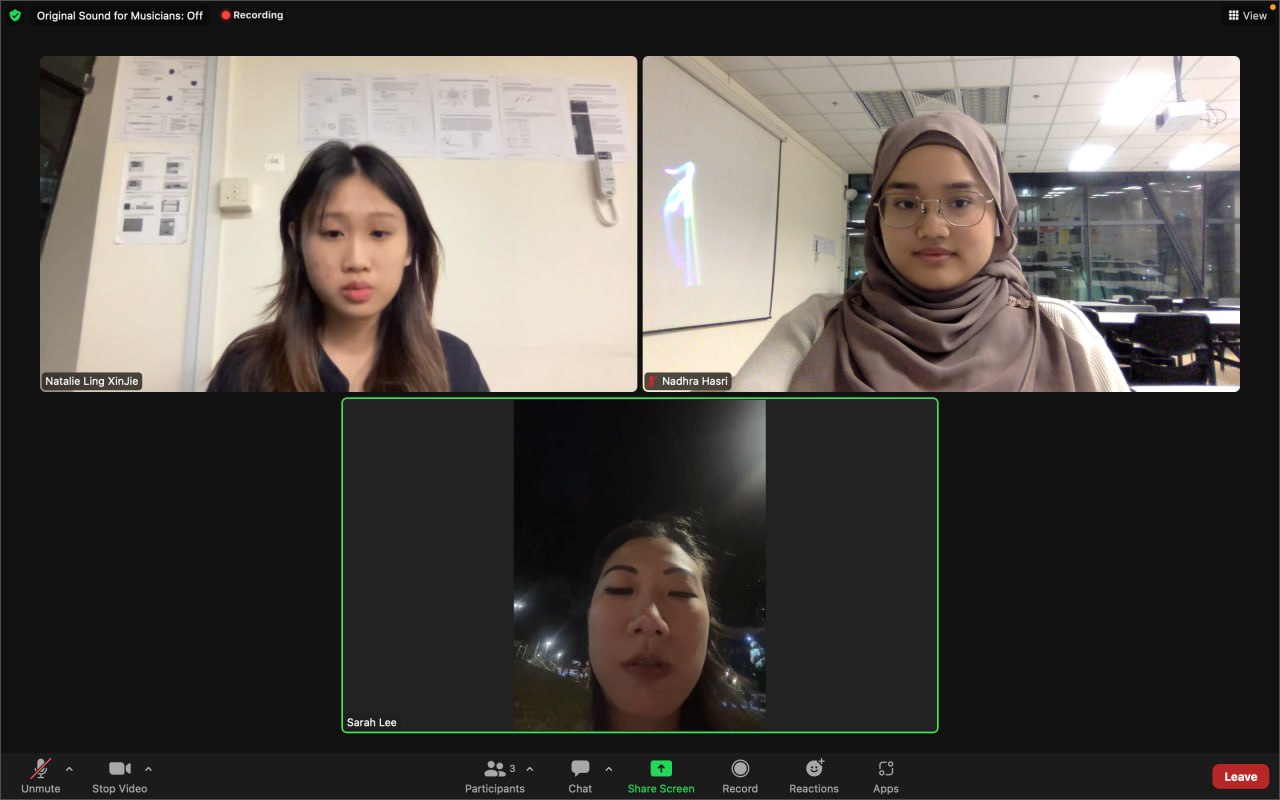
Interviews for data collection
This was a screenshot from our interview with Sarah Lee of NEON Global. She was the one who got Kamini on board for AVATAR: The Experience at Gardens By The Bay. We got to talk to her more about how working with Kamini was like, and she shared her insights on Kamini's expertise as a Guest Experience Consultant.
Context and problems
THE PROBLEM: How can Kamini better attract non–creatives for Creative Storytelling Consultancy services
Throughout her career, Kamini receives storytelling–related requests from non–creative companies. However, according to Kamini, she struggles in understanding how to get these non–creative companies to reach out to her for creative consultancy instead of storytelling.
According to Kamini, she is able to help non–creative organisations in ways beyond simply storytelling. She is able to undertake roles that involve ideation and conceptualisation, help with problem–solving, production and the execution of ideas. With over two decades of experience as a teaching artist, a creative producer, an expert in Southeast Asian heritage, a creative placemaker, a community arts practitioner, and an advocate for the arts, Kamini wishes to pivot to a consultancy role for these non–creative organisations to tap on.
For example, Kamini received a request to do a storytelling segment for La Prairie’s Platinum Rare skincare launch party. Division Communications (events agency) reached out to her after seeing her extensive storytelling portfolio on Moonshadows Stories. On another example, NEON Global reached out to Kamini when they saw her storytelling experience on Moonshadows Stories, but later on after much interaction with her, did they veer towards creative consultancy instead of storytelling and writing.
To summarise, Kamini is well–known within the arts and non–arts industries as a master storyteller. However, there is insufficient information about her consultancy abilities on her website. As a result, little is known about this portion of Kamini’s skillset. Therefore, the team has been tasked with rewriting Kamini’s About Us page to feature more of her career than just her storytelling experiences.
In addition to that, Kamini also tasked the team to create a LinkedIn profile for her. With over 20 years of experience in a variety of roles that range from heritage expert to teaching artist and creative producer, Kamini is overwhelmed by the sheer volume of job roles and experiences she has. Displaying these experiences and segmenting them on LinkedIn has proven to be a challenge for her as she is new to the platform. Therefore, the team was asked to help Kamini streamline and simplify her experiences into a classic, easy-to-ready LinkedIn page in order to showcase more of her portfolio in consultancy.
In order to complete both deliverables, the team must first understand three things: (1) what is Kamini’s new target audience, (2) what do they look for in a creative consultant and (3) how best can we appeal to them through Kamini’s website and LinkedIn page.
Team Members and Roles
Natalie Ling XinJie: Leader
Esther Yeon Ling Yuan: Research / Group Member
Nadhra Binte Hasri: Research / Group Member
Each member contributed heavily throughout the span of the project. Natalie oversaw organising meetings and the project timeline, setting important milestones to guide her group mates to the project submission.
Esther assisted with taking meeting minutes for all our meetings with Jason and Kamini, and helped to conduct a portion of the interviews as part of our methodology. She also helped to create and operationalise our presentation deck on MIRO.
Nadhra assisted with the crafting and standardisation of our LinkedIn deliverable, and assisted with research that was key to guiding our understandings during our project duration.
All team members also helped to edit and finalise the drafts of our deliverables to be submitted to Kamini.
Key Goals and Objectives
THE OBJECTIVE: To help Kamini refresh her Moonshadows Stories website and LinkedIn page to get non–creatives to approach her for creative consultancy
What we want is to help Kamini effectively showcase the relevant skills with precise terminology to attract non–creatives looking for a creative consultant, while not losing touch with who she is as a storyteller.
The task at hand is essentially to develop a new audience segment for Kamini. The team has identified a specific target audience segment of non–creatives which is: non–creatives working in the Marketing/Public Relations/Events Management spheres. These professions are also built upon storytelling – be it storytelling through a marketing campaign, rebranding work or building an immersive experience like AVATAR at Gardens By The Bay. As such, the work of these non–creatives falls within Kamini’s experience and expertise, and will be likely to seek guidance from her. In order to understand how best to appeal to this new target audience, the team must first set out to understand the needs and wants of this new audience segment (this is further expanded on in the methodology segment below).
A key goal for this project is to help Kamini condense and streamline her decades worth of experiences in multiple areas into a format that is easy to understand and straightforward. At this point, an issue the team faced was how to streamline hundreds of experiences across a variety of different areas like heritage, mentorship and producing. The team had to come up with different solutions on how to tackle this issue.
Project Timeline
Within the project timeline, the team made sure to have regular check–ins with Jason as well as milestone meetings with Kamini. These meetings with Kamini were to gather her feedback on our progress, and to make sure our solutions and approaches were in line with what she had requested from us at the start. We also use these meetings to gather feedback before making decisions where appropriate.
Week 4, 1 February
- Ideation and finalisation of project outline, role allocation and teamwork approach
- Research Phase
- Team to conduct research into Kamini’s background and career
- Team to compile research for easy reference and access
- Clarify necessary questions
Week 5, 8 February
- Research Phase
- Team to continue research into Kamini’s background and career
- Ideation Phase
- Brainstorming keywords, phrases and themes to promote cohesion across website and LinkedIn
- Critical review of presented ideas
- Categorising ideas into (1) for website and (2) for LinkedIn
- Shortlisting feasible and innovative ideas to move forward with
- Reference research done into Kamini’s background
- Would be helpful to use resources like her current resume (job history), IG and other social platforms.
Week 6, 15 February
- Presenting ideas for comments and feedback (Jason and Kamini)
- Reviewing feedback as a group
- Ideation Session
- To start thinking of how to move forward with cementing Problem Statement, Objective and Methodologies
Week 7, 22 February
- Ideation phase
- Revisiting feedback, refreshing previous ideas or implementing new ideas
- Confirmation of Problem Statement, Objective and Methodologies
Week 8, 8 March
- Team to submit progress for feedback with Jason
- Team to make necessary amends with feedback
- Team to review feedback as a group
Week 9, 15 March
- Team to begin preparations for next phases of methodology
- Preparation for interview and survey to be conducted
- Interview questions to be drafted preliminarily for Jason’s approval
- Survey questions to be drafted for Jason’s approval
Week 10, 22 March
- Team to present interview questions and survey for approval from Jason
- Team to make necessary changes based on Jason’s feedback
- To proceed with reaching out to interviewees for interviews in the week of 29 March
- Survey is to be sent out to relevant target audience
Week 11, 29 March
- Team to complete interviews with all relevant personnel within this week
- All interview findings are to be logged into the team Google Drive
- All survey data to be logged and analysed before writing phase
- Presenting progress for comments and feedback (Jason)
- Team to review feedback and comments together
- Checking for cohesion and alignment
- Solidifying ideas at this stage
Week 12, 5 April
- Team starts writing
- To review through multiple drafts of both About Us page and LinkedIn information bank
- Team to check in with both Jason and Kamini before presentation day
Week 13, 12 April
- Preparation for submission
- Final feedback, comments and changes
Project Methodologies
THE METHODOLOGY: AUDIENCE SEGMENTATION
Research Point: Why use Audience Segmentation as the methodology?
A definition by mailchimp states that audience segmentation is a strategy “based on identifying subgroups within the target audience in order to deliver more tailored messaging and build stronger connections” (Mailchimp) To create a more robust and targeted messaging in Kamini’s website and LinkedIn for non–creatives, audience segmentation is used to develop a deeper and fuller understanding of our target audience.
Reference: Mailchimp. “Audience Segmentation: Basics of Audience Segmentation | Mailchimp,” n.d. https://mailchimp.com/en-gb/marketing-glossary/audience-segmentation/.
The audience segmentation is done in two parts:–
- IDENTIFYING SUB-GROUPS WITHIN AN EXISTING AUDIENCE
- Kamini already works non-arts organisations (Merry Men Works, NEON Global, Division Communications), who enlist her services as a storyteller. Within this audience of non–creatives, we’re targeting those specifically in Marketing, Public Relations and Events Management sectors only. The target audience identified will comprise non–creative aged 21 – 50 in the Marketing, Public Relations and Events Management sectors.
- When identifying these sub–groups, it was important to the team to understand how the relevance between Kamini and the audience in these sub–groups. We chose Marketing, Public Relations and Events Management professionals because these professions already have elements of storytelling. For example, Marketing professionals use storytelling as a way to curate targeted video messages for campaign launches. Therefore, Kamini's skillset would be of great relevance to these three sub–groups in particular.
- UNDERSTANDING THESE SUB-GROUPS
- To develop a better understanding of the needs and wants of this sub–group, the team is using qualitative and quantitative research methods.
- (1) Focused interviews with non–arts organisations and individuals Kamini has worked with in the past
- (2) A targeted survey for non–creatives aged 21 – 50 in the Marketing, Public Relations and Events Management sectors.
- To develop a better understanding of the needs and wants of this sub–group, the team is using qualitative and quantitative research methods.
For the interviews, the team has opted to make use of the Johari Window Model framework.
About the Johari Window Model:
A graphic model developed by Joe Luft and Harry Ingram (hence the name Johari, from their first names) of behaviour in groups is popularly known as the Johari Window 7. The Johari window consists of four quadrants. The four represent the total person in relation to other persons. The rationale for the division into quadrants is the awareness of behaviour, feeling and motivation. An act, a feeling, or a motive is assigned to a particular quadrant based on who knows about it. As awareness changes, the quadrant to which the psychological state is assigned changes.
Reference: Afolabi, Michael. 1993. "Application of JOHARI Communication Awareness Model to Special Libraries Management." Library Management 14 (1): 24. https://www.proquest.com/scholarly-journals/application-johari-communication-awareness-model/docview/198860714/se-2.
Due to its flexible nature, the team chose the Johari Window Model framework over other self–awareness models to frame our interviews. The model allows a more customisable approach to tackling our problem statement, and made it much more suitable to use as the team was able to adapt the model to our project requirements. Additionally, this model in particular allows for a more holistic approach in our data compilation, because Kamini herself is able to provide feedback on what she thinks of herself, in addition to what the interviewees think of her. As the nature of our problem–statement deals with perception, it is equally important to have Kamini's input in addition to the input of our interviewees. This allows the team to create a well–structured and balanced list of adjectives and terminology to utilise when writing.
Following that, the team will also employ the use of Behavioural and Psychographic and Attitudinal Segmentation in both the interview and survey questions to better understand our new target audience. The questions will deal with behaviour patterns and preferences.
Questions were created to understand how these professionals in Marketing, Public Relations and Events Management think in the workplace. For example, questions were asked to find out more about the kind of problems they typically face in their field of work, as well as how they would resolve them. This data enables us to understand where and how Kamini's skillset would be relevant to them.
Once data from the interviews and survey have been collected, the team will review the findings and highlight key takeaways. The next step is to conduct research into possible case studies to tap on to generate a greater understanding on how best we can tackle our problem–statement. This is done by compiling two examples of arts individuals who have also pivoted from being arts practitioners to consultants.
Case Study #1: Sheila Wee
- Sheila is a professional storyteller of over 20 years. She was instrumental in the development and organisation of the Asian Congress of Storytellers and the International Storytelling Showcases (from 2000 to 2009) which in 2006 were rebranded as the Singapore International Storytelling Festival. Sheila is a founding Professional Member and Committee Member, a 4 term President, 3 term Vice-President and the current Workshop Chair of the Storytelling Association (Singapore).
- As well as running her storytelling company Storywise, Sheila is a director of Story Connection, a non-profit company she set up with fellow storyteller Roger Jenkins, to run the annual 398.2 Storytelling Festival, the Storytelling Carnival @ Enabling Village and other community storytelling events. Shew is also a founding director of FEAST (Federation of Asian Storytellers)an international non-profit which supports Asian storytellers and promotes the development of storytelling in Asia.
Case Study #2: Adam Tie
- Adam Tie is the founder of The Novel Encounter, a business that focuses on creative projects revolving around poetry and mental wellness. He is also a published poet and author, and is best known for his typewritten poetry. Adam has been engaged by a variety of brands, organisations, schools and special events.
- While Adam is not necessarily pivoting to a consultancy role, he practices his craft (poetry) while also taking on the role of founder (The Novel Encounter) and offering creative marketing solutions to brands and corporations in Singapore. His experience as a poet, author and founder of a business has allowed him to expand his skillset beyond just the arts.
- His ability to write relatable text that appeals and attracts as he intended has become a powerful tool that is of interest to professionals, corporations and brands looking for creative marketing solutions.
Proposed Solution: The team will come up with a working vocabulary of keywords and terminology to be used when drafting Kamini’s new About Us page and LinkedIn profile. These keywords will be formed based on the data and findings from our research, interviews and survey. The team will then use this newly acquired data to complete Kamini’s deliverables.
But why is an active vocabulary important?
Keeping marketing vocabulary and terminologies precise is important to prevent using words with many meanings which confound and confuse. This eventually causes the words to lose meaning. Improper definitions of branding terminology can cause confusion, and data can becomes irrelevant because readers are not sure if the information is applicable (Schutte 1969). In other words, using the right terminology intentionally is key to tackling our problem statement. Creating an active vocabulary would help the team track keywords that are useful to us, while removing those that are not.
Reference: Schutte, Thomas F. 1969. “The Semantics of Branding.” Journal of Marketing 33, no. 2. 5–11. https://doi.org/10.2307/1249395.
To further verify the reliability and accuracy of our data, the team will also compare and contrast our writing against the case studies we have identified. Because we want to understand how these individuals have rebranded themselves through their writing, taking inspiration from the way they have drafted their own For You page will enable us to identify any issues with how we choose to draft Kamini's new About Page and LinkedIn profile.
Project Research Insights
Interview Insights:
About Kamini:
- Kamini is already known to non–creatives and creatives alike as a storyteller. Her branding as a storyteller is extremely clear and straightforward, a simple search grants you a myriad of information about Kamini as a storyteller in Singapore.
- Kamini is extremely well–connected within the arts industry. She has an ability to connect with creatives ranging from producers to artists and even those in the C+ suite. However, this is often overlooked in favour of her storytelling expertise and career.
- Kamini has an intrinsic understanding of local audiences, and is able to predict what they need and want after working as a storyteller for two decades. This grants her insight that is useful to organisations looking for new ways to attract and appeal to the local audiences.
- Kamini is extremely approachable, and uses her kind demeanour as a way to interact and communicate with the people and organisations she works with. She is empathetic to those around her, allowing her to better understand their needs and wants, which then enables her to think of ways of how best to assist them.
- With a career in the arts that spans two decades, Kamini is unafraid to use her connections in the arts industry. With years of experience under her belt, she is surrounded by an aura of confidence and assuredness that brings reassurance to those working with her.
Others:
- The term 'Creative Consultant' indicates that the person must have creative roots or work in the creative industry. Someone who is not a creative cannot call themselves a creative consultant.
- Non–arts organisations tend to look for creatives like Kamini who have a deep understanding and knowledge of local audiences
Survey Insights:
- A majority of respondents indicated that they strongly agreed that storytelling is an essential part of their work, and believed in creative problem–solving in the workplace
- A majority of respondents also indicated that they did not know what a Creative Storytelling Consultant is and does
- As a result of this, most respondents indicated 'Neutral' and 'Agree' when asked if they thought that a Creative Storytelling Consultant would be helpful in their line of work
- This is different from respondents who did know about a Creative Storytelling Consultant, with most citing 'Strongly Agree' when asked if they thought a Creative Storytelling Consultant would be helpful in their line of work
- Also, respondents who knew what a Creative Storytelling Consultant is were more likely to want to engage the help of one in their workplace compared to those who indicated that they did not know what a Creative Storytelling Consultant is
These survey findings indicate that the levels of willingness to work with and engage a Creative Storytelling Consultant is directly affected by an understanding or knowledge of what a Creative Consultant is and does.
Project Vision and Expected Outcomes
As part of the team's initial discussions with Kamini, she had relayed that she liked the About Us pages by Curator, Programmer and Producer Giulia Poli and dance collective Assembly 197. These two About Us pages were her inspiration for her own About Us page on Moonshadows Stories. Therefore, the team's vision for the project was heavily influenced by the writings from both Giulia Poli and Assembly 197.
Giulia Poli: https://www.giuliapoli.org/resume
Assembly 197: https://www.assembly197.com/about
At first glance, it was clear that both Giulia Poli and Assembly 197's About Us pages were written to convey a sense of self, and framed in a way that depicted their best attributes, achievements and skills. These were important guiding points when the team was tackling Kamini's About Us page. While we did not reuse any similar design when it came to the page layout or wording, we were intentional in noting how these Giulia Poli and Assembly 197 had arranged the information in a digestible format.
As such, the team expected to create an About Us page that not only accurately conveyed who Kamini is as an artist and storyteller, but also as a consultant, teaching artist, producer, heritage expert and arts advocate. It was crucial for the team to present all this information in a format that was easy on the eyes, while also impactful and uniquely Kamini.
For Kamini's LinkedIn page, she had emphasised on the term simplicity. She wanted the team to help her streamline her decades of experiences into a single page. As Kamini is new to the LinkedIn platform, the team was governed by a principle of minimalism – focusing on categorising her experiences in a pragmatic way to ensure that it's digestible and easy to search for. While she had no specific vision in mind for her LinkedIn page, the team took created the LinkedIn page to be cohesive with language used in the About Us page.
If successful, the team expects Kamini to receive an uptake in requests on consultancy from professionals and organisations in the Marketing, Public Relations and Events Management spheres.
Project Deliverables and Outputs
1. About Us page draft for Moonshadow Stories
2. An information bank for Kamini's LinkedIn profile
The About Us page draft is presented on a document for ease of access, so Kamini may simply copy and paste it on her website when necessary.
However, for Kamini's LinkedIn profile, the team had to devise a way to present the information so that Kamini could have a way to easily transfer the experiences we've curated for her onto a new LinkedIn profile. As such, the team came up with the idea of an information bank – where all Kamini's different and key experiences are highlighted and logged in a systematic format that models the actual LinkedIn page. All experiences are categorised by organisation for ease of understanding, and every organisation has a list of job experiences within it. Every individual experience under an organisation is tagged with a category, which can be found in a legend on the first few slides of the information bank.
These categories denote the key skillsets Kamini has and wishes to feature. For example, heritage expert or international practitioner. All individual experiences are tagged with one or more of these categories, which then double as keywords to ensure that Kamini's profile appears as often as possible during LinkedIn searches. This method of categorisation allows for a more streamlined appearance for Kamini's LinkedIn page, while using an information bank to store her experiences is intuitive and easy to use. With the information bank, Kamini can very easily add or edit the experiences we've added and use the information bank as a reference for when she creates her actual LinkedIn profile.
The team did not create an actual LinkedIn profile for Kamini during this project due to security reasons. Kamini had commented that she did not want a public LinkedIn profile to be created yet. Therefore, the team devised a plan to utilise an information bank for the timebeing.
SWOT analysis
The team has made use of the Red and Blue ocean framework to better understand how Kamini can be better positioned with her About page.
For Kamini, a potential threat in the red ocean was the presence of other creative consultants offering similar services. However, to combat this issue, the team and Kamini have devised a new term called a Creative Storytelling Consultant. This term is unique to Kamini, and there are no other professionals with the same title. This places Kamini in the blue ocean, because it carves out a new market space for her.
While there are an abundance of creative consultants in Singapore (red ocean), Kamini's unique selling point is the element of storytelling. As one of Singapore's pioneering storytellers and most prominent performative storytelling artist, Kamini is able to draw on her decades of experience in storytelling to creatively consult, advise and problem–solve. This differentiates her from other creative consultants in Singapore who draw inspiration and knowledge from other areas.
Another potential threat in the red ocean was Kamini's new audience. Creative consultants offer their services and expertise to anyone and any organisations looking to creatively problem–solve. This comprises of a large segment of people and audiences, anywhere from Advertising to Food and Beverage and even Engineering. However, Kamini's new target audience (professionals aged 21 – 50 in the Marketing, Public Relations and Event Management fields) is a sub–group of a larger network of audiences (non–creatives or corporations). This makes her audience more of a niche, allowing Kamini to focus her messaging efforts to this audience group. As mentioned above, these professions all contain heavy elements of storytelling, creating a connection with Kamini that is unique only to her. This makes the services that she offers different to other creative consultants in the field. Thus placing her once again, in the blue ocean.




